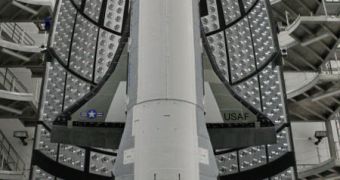According to reports coming in from experienced satellite trackers, it would appear that the X-37B robotic space plane has recently moved to a new orbit around the planet.
The concept associated with the vehicle was first developed at NASA, but the organization passed on the projects to colleagues at the Defense Advanced Research Projects Agency (DARPA).
Officials here proceeded to immediately classify the project, and the faith of the X-37B has remained a secret even now, after it was launched.
There was no official announcement from DARPA or the US Department of Defense as to the orbital maneuvering, and there probably won't be any in near future.
The orbital changes were first noticed by Greg Roberts, an amateur satellite tracker based in Cape Town, South Africa. He did not exactly discovered the new orbit, but rather the fact that the X-37B left its previous orbit.
After a few nights of observations, the DARPA space plane was discovered on August 19 in a new orbit. Roberts and other amateur astronomers then calculated the new orbit, which was confirmed by subsequent observations.
The secretive robotic spacecraft was launched earlier this year, on April 22, from the Cape Canaveral Air Force Station (CCAFS), in Florida.
The robotic ship was inserted in its destined orbit by a heavy-lift Atlas 5 delivery system. Officially, this particular space plane is called the Orbital Test Vehicle-1 (OTV-1), Space reports.
“Following the successful launch and initialization, the first flight of the X-37B Orbital Test Vehicle (OTV-1) continues to focus on checking out the on-orbit performance of the vehicle and proving the technologies required for long-duration, reusable space vehicles with autonomous re-entry and landing capabilities,” says for Space Andy Roake, who is spokesman for the US Air Force (USAF).
Under a special set of space exploration plans the DOD has been pursuing since the disaster of space shuttle Challenger, the new spacecraft is meant to stay in orbit for as long as 270 days.
The unmanned space vehicle exceeds the performances of the existing space shuttles in almost all aspects, but especially in terms of autonomy. The X-37B has already been in orbit for 123 days.
“After the test objectives are satisfied, we look forward to a successful re-entry and recovery at Vandenberg Air Force Base, California, and post-landing refurbishment of the vehicle. No landing date has been scheduled,” says Roake.

 14 DAY TRIAL //
14 DAY TRIAL //